
The Master of the Castello Nativity was an Italian religious artist of the mid-15th century. He was a follower of Fra' Filippo Lippi and was probably employed at his workshop in Prato.

The Master of the Castello Nativity was an Italian religious artist of the mid-15th century. He was a follower of Fra' Filippo Lippi and was probably employed at his workshop in Prato.
His notname derives from a panoramic painting of the Nativity, originally at the Chiesa di San Michele a Castello ; now in the collection of the National Gallery in London.
He specialized in paintings for devotional purposes, featuring the Virgin and Child or related scenes. Typically characteristic of his work are the variations in placement and pose of the Child in the Virgin's arms; something which is generally more static.
In 1995, Chiara Lachi, of the Marino Marini Museum, identified him as the young Piero di Cosimo, [1] a proposal that has received little agreement. In the exhibition catalog, Officina pratese, edited by Andrea De Marchi of the University of Florence [2] , speaks of Piero di Lorenzo di Pratese di Bartolo Zuccheri, documented around 1450 as the author of an altarpiece for the Chiesa dei Santi Giusto e Clemente a Faltugnano , as a possible candidate. That work is now divided between museums in Prato, London and Philadelphia.

Filippino Lippi was an Italian painter working in Florence, Italy during the later years of the Early Renaissance and first few years of the High Renaissance.
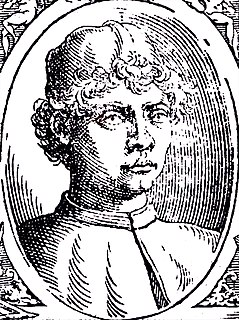
Piero della Francesca, originally named Piero di Benedetto, was an Italian painter of the Early Renaissance. To contemporaries he was also known as a mathematician and geometer. Nowadays Piero della Francesca is chiefly appreciated for his art. His painting is characterized by its serene humanism, its use of geometric forms and perspective. His most famous work is the cycle of frescoes The History of the True Cross in the church of San Francesco in the Tuscan town of Arezzo.

Domenico di Michelino (1417–1491) was an Italian Renaissance painter who was born and died in Florence. His real name was Domenico di Francesco. The patronymic "di Michelino" was adopted in honor of his teacher, the cassone painter Michelino di Benedetto, by whom no works have been identified. Giorgio Vasari reports that Domenico was also a pupil of Fra Angelico, whose influence is reflected in many of Domenico's paintings along with that of Filippo Lippi and Pesellino.

Pietro Perugino, born Pietro Vannucci, was an Italian Renaissance painter of the Umbrian school, who developed some of the qualities that found classic expression in the High Renaissance. Raphael was his most famous pupil.
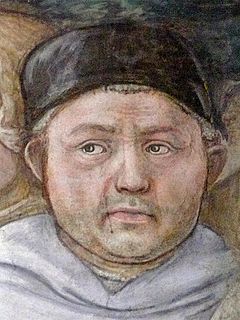
Fra'Filippo Lippi, also known as Lippo Lippi, was an Italian painter of the Quattrocento and a Carmelite Priest.

Prato is a city and comune in Tuscany, Italy, the capital of the Province of Prato. The city lies 17 kilometres north-west of Florence, at the foot of Monte Retaia, elevation 768 metres (2,520 ft), the last peak in the Calvana chain. With more than 195,000 inhabitants, Prato is Tuscany's second largest city and the third largest in Central Italy.
The decade of the 1460s in art involved some significant events.
The decade of the 1450s in art involved many significant events, especially in sculpture.
The decade of the 1440s in art involved some significant events.
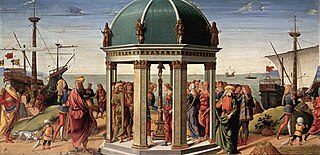
Biagio d’Antonio Tucci was an Italian Renaissance painter active in Florence, Faenza and Rome.

Domenico di Zanobi, formerly known as the Master of the Johnson Nativity, was an Italian Renaissance painter. His exact dates of birth and death are not known. He is documented as a mature artist from 1467 until 1481.

The Master of Pratovecchio was an Italian painter of the Renaissance, named by Roberto Longhi in a 1952 article on the basis of stylistic similarities of a number of works to an altarpiece painted for the monastery of San Giovanni Evangelista in Pratovecchio. The centre panel of the triptych, depicting the Assumption of the Virgin is currently on deposit in Arrezo; the left and right side-panels are in the National Gallery, London.
Piero di Lorenzo di Pratese di Bartolo Zuccheri was an Italian painter. His exact dates of birth and death are not known.
Giovanni di Francesco del Cervelliera or Giovanni di Francesco was an Italian painter, active in Florence in the mid-fifteenth century.
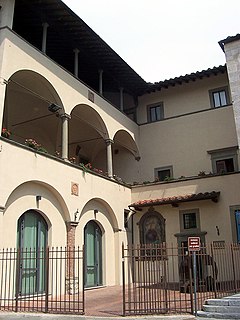
The Cathedral museum of Prato, Italy was founded in 1967 in a few rooms of the Bishop's residence and in 1976 grew to include items from both the Cathedral of Saint Stephen and the diocesan territory.
The following is a timeline of the history of the city of Prato in the Tuscany region of Italy.

Adoration of the Christ Child with Saint Jerome, Saint Mary Magdalene and Saint Eustace is a c.1436 tempera and gold on panel painting by Paolo Uccello. It is now in the Staatliche Kunsthalle in Karlsruhe. Its provenance is unknown, though it may have come from the church of Santi Girolamo e Eustachio in Bologna during the artist's stay in Emilia-Romagna.
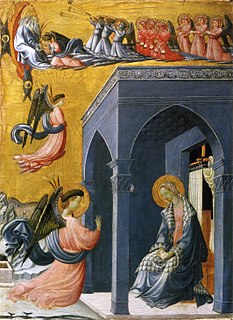
Annunciation is a gold and tempera on panel painting by Paolo Uccello executed c. 1425. It is now in the Ashmolean Museum in Oxford, England, to which it was given by William Thomas Herner Fox-Strangways in 1850.

Crucifixion with Two Angels is a tempera and gold on panel painting by Paolo Uccello, executed c. 1423, now in a private collection.
| Wikimedia Commons has media related to Master of the Castello Nativity . |